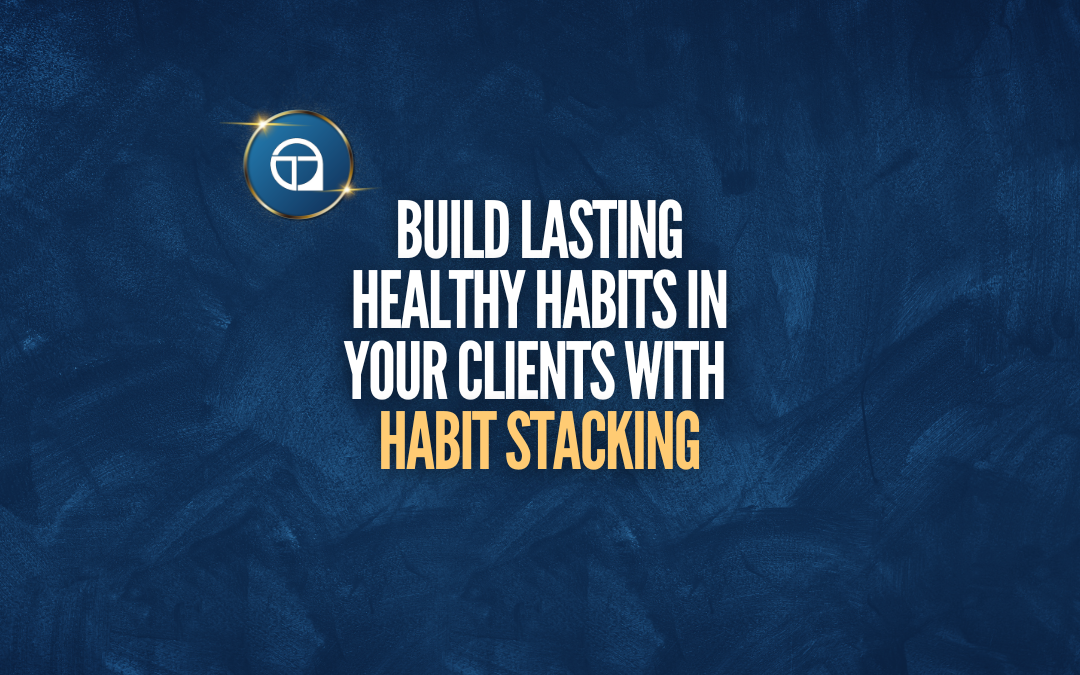As a coach, you likely have figured out that one of the biggest hurdles clients face isn’t just hitting their workouts or following a diet, it’s consistency. They start strong, full of enthusiasm, only to fizzle out after a few weeks. That’s where habit stacking comes in. This simple yet powerful technique can help your clients build lasting healthy habits by anchoring new behaviours to existing ones.
Let’s break down the concept and how you can implement it to create real change for your clients.
What Is Habit Stacking?
Habit stacking is a concept I first heard about in James Clear’s book Atomic Habits. The idea is simple: you take an ingrained habit from your daily routine and pair it with a new, actionable habit relevant to your health and fitness goals. Think of it as piggybacking one habit onto another.
This works because the brain craves efficiency. Once a behaviour becomes automatic, it’s like your brain creates a shortcut, saving energy. By stacking habits, you’re leveraging those existing neural pathways to build new ones.
For example, let’s say your client already brushes their teeth every morning (an ingrained habit). You could suggest they take three deep breaths to start their day with some mindfulness, if they need to work on their stress management and struggle to do it at other times during the day.
The trigger (brushing their teeth) becomes the cue for the new habit.
Why Habit Stacking Works
There’s a reason this method is so effective: it taps into how our brains are wired. Humans are creatures of habit, and much of our daily behaviour is on autopilot. If you’ve ever done your daily commute and barely remembered the trip, you’ve experienced this.
Habit stacking creates intentionality around that autopilot mode. It’s a way to “hijack” an existing routine and insert a small change that eventually becomes just as automatic.
In addition, habit stacking capitalises on the principle of “cue-based learning.” This means the existing habit acts as a clear, predictable trigger, making it easier for clients to remember and execute the new habit. This structure helps to reduce perceived decision fatigue and fosters consistency.
Starting Small for Long-Term Success
One of the biggest mistakes I’ve seen personal trainers and nutritionists make is trying to overhaul a client’s entire lifestyle at once. That’s a recipe for overwhelm and burnout. Instead, you can use something like habit stacking, which encourages incremental change. The new habit you’re adding should be so small it feels almost effortless.
For example, let’s say you work with a busy professional trying to stay on top of her hydration goals. Instead of telling her to chug a 3L a day from the get-go, we start with something simple: every morning after she starts her coffee maker (an existing habit), she fills up her bottle of water for the day.
She doesn’t have to necessarily even drink all that water throughout the day, but she drastically increases her likelihood of drinking sufficient water if she actually has the water ready to go when she needs it.
The Anatomy of a Habit Stack
A successful habit stack follows a simple formula:
After [current habit], I will [new habit].
Here are a few examples you can suggest to clients:
- After I brew my morning coffee, I will do 10 push-ups.
- After I finish lunch, I will take a 5-minute walk.
- After I put my kids to bed, I will stretch for 5 minutes.
- After I park my car at work, I will take the stairs instead of the elevator.
Notice how the current habit acts as the trigger for the new habit. These small actions might not seem significant on their own, but they’re the building blocks of lasting change.
Of course, I can come up with a million and one generic habits, but as a coach, your goal is to come up with the specific habits that will help your clients get closer to their goals. This is contingent on you knowing what to do, so if you don’t feel confident in your abilities, then check out our courses to upskill.
Expanding the Habit Stack
Once a client successfully implements one habit stack, encourage them to build on it. For example, if they’re consistently drinking water after starting their coffee maker, suggest adding a short meditation practice before their first sip. This creates a chain of positive behaviours that reinforce each other.
The beauty of habit stacking is that it often creates a ripple effect. Once a client builds confidence in their ability to stick to one small habit, they’re more likely to take on others. These small wins compound over time, leading to significant lifestyle changes.
As a coach, your role is to guide your clients through this process with patience and encouragement. Habit stacking isn’t about quick fixes, it’s about creating a sustainable framework for long-term success.
You want to build lasting healthy habits in your clients, not just some quick fix solutions. Providing them with skills for life should always be the priority.
Tips for Coaching Habit Stacking Effectively
When introducing habit stacking to your clients, keep these tips in mind:
- Understand Their Routine: Start by mapping out your client’s current habits. Ask questions about their day-to-day life to identify consistent behaviours you can use as anchors.
- Make It Specific: Vague goals don’t stick. Instead of saying, “Drink more water,” say, “Drink one glass of water before your morning coffee.” The more specific the habit stack, the easier it is to follow.
- Focus on One Change at a Time: Don’t overwhelm your clients with multiple new habits. Start with one, and once it’s established, add another.
- Track Progress: Encourage clients to track their habit stacks using tools like fitness apps, hydration trackers, or even simple paper checklists to ensure they stay consistent and motivated.
- Celebrate Small Wins: Positive reinforcement is crucial. Celebrate when your client consistently completes their habit stack, no matter how small the action.
Overcoming Common Challenges
Of course, not every habit stack will work perfectly right away. Clients might forget or feel resistance. That’s normal. Here’s how to troubleshoot:
- If They Forget: Suggest tying the habit to a more noticeable anchor. For instance, if brushing their teeth doesn’t work as a trigger, try using “starting the coffee maker” or “checking their phone in the morning” instead.
- If It Feels Too Hard: Scale back the habit. If a client can’t manage 10 pushups, start with 1. Success builds momentum.
- If They Lose Motivation: Revisit their “why.” Remind them of the bigger picture and how these small habits contribute to their goals.
Build Healthy Habits In Clients With Habit Stacking Final Thoughts
By teaching your clients the art and science of habit stacking, you’re equipping them with a powerful strategy they can apply in every aspect of their health journey. Small changes lead to big results.
We have a lot of free content available in our content hub, if you want to learn more. If you want even more free information, you can follow us on Instagram, YouTube or listen to the podcast. You can always stay up to date with our latest content by subscribing to our newsletter.
Finally, if you want to learn how to coach nutrition, then consider our Nutrition Coach Certification course, and if you want to learn to get better at exercise program design, then consider our course on exercise program design. We do have other courses available too. If you don’t understand something, or you just need clarification, you can always reach out to us on Instagram or via email.

